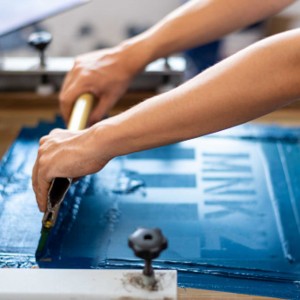
Screen printing is a printing technique that involves pressing ink through a fine mesh screen onto a substrate, such as fabric, paper, or plastic.
The process typically involves the following steps:
- Preparation: The screen is coated with a light-sensitive emulsion and exposed to a positive image of the design to be printed. The emulsion hardens where it is exposed to light, but remains soft in the areas that are blocked by the positive image.
- Washing: The screen is then washed with water, which removes the soft, unexposed emulsion, leaving a negative image of the design on the screen.
- Printing: Ink is placed on top of the screen, and a scraper is used to press the ink through the holes in the screen and onto the substrate. The screen is then lifted, and the process is repeated until the desired number of prints have been made.
- Drying: The printed substrate is then placed in a drying area, where the ink is allowed to cure or dry.
There are several variations of the screen printing process, including hand screen printing, machine screen printing, and heat transfer printing. The specific method used may depend on the type of substrate being printed, the type of ink being used, and the desired quantity and quality of the prints. Screen printing is often used to produce high-quality, long-lasting prints on a variety of materials and is commonly used in the production of clothing, signage, and other printed products. Contact us for your next printing job and let us guide you to the right process for your material.
